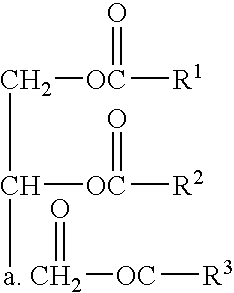Melting Vegetable Protein Based Substitute Cheese
- Summary
- Abstract
- Description
- Claims
- Application Information
AI Technical Summary
Problems solved by technology
Method used
Image
Examples
example 1
[0089]A soy protein isolate is prepared in which 180 pounds per minute of defatted soybean flakes are added to an extraction tank to which is added 1080 pounds per minute of water which is heated to about 32° C. (90° F.). The soy flakes are extracted for a period of 30 minutes after which the aqueous solution is separated from the extracted flakes by centrifugation. The first aqueous extract is held while the extracted flake residue is redispersed in 720 pounds per minute of water at a temperature of 32° C. (90° F.). The pH of the mixture at this point is 6.8.
[0090]A second aqueous extract from the flakes is obtained by centrifugation and combined with the first aqueous extract. To the combined extracts, 37% hydrochloric acid is added to adjust the pH to about 4.5 and precipitate the protein. The precipitated protein is then centrifuged to remove excess liquid to a solids level of 20-25% by weight. The precipitated protein is then diluted with water to form a slurry having a solids ...
example 2
[0098]Water (129.2 g) at a temperature of 75° C. (167° F.) is added to a food processor followed by 23.07 g of SUPRO® 220 having a viscosity of 20 centipoise and 5.54 g of carrageenan. The contents are combined at high speed for one minute. Palm oil (13.3 g) and 20.12 g coconut oil are added and combined at high speed for two minutes. Then added are 0.46 g sodium ascorbate, 1.85 g cheese flavorant, and 1.85 g table salt. The contents are combined at high speed for five minutes. Then added are 4.61 g starch and the contents are combined at high speed for one minute. The temperature is increased to about 90° C. (194° F.). The contents are cooled to room temperature and placed in a mold.
example 3
[0099]Water (123 g) at a temperature of 75° C. (167° F.) is added to a food processor followed by 26.35 g of SUPRO® 220 and 5.27 g of carrageenan. The contents are combined at high speed for one minute. Palm oil (12.65 g) and 19.15 g coconut oil are added and combined at high speed for two minutes. Then added are 0.44 g sodium ascorbate, 3.51 g lactic acid, 0.88 g salt, 2.64 g annatto, and 1.76 g dextrose. The contents are combined at high speed for five minutes. Then added are 4.39 g starch and the contents are combined at high speed for one minute. The temperature is increased to about 90° C. (194° F.). The contents are cooled to room temperature and placed in a mold.
PUM
 Login to View More
Login to View More Abstract
Description
Claims
Application Information
 Login to View More
Login to View More - R&D
- Intellectual Property
- Life Sciences
- Materials
- Tech Scout
- Unparalleled Data Quality
- Higher Quality Content
- 60% Fewer Hallucinations
Browse by: Latest US Patents, China's latest patents, Technical Efficacy Thesaurus, Application Domain, Technology Topic, Popular Technical Reports.
© 2025 PatSnap. All rights reserved.Legal|Privacy policy|Modern Slavery Act Transparency Statement|Sitemap|About US| Contact US: help@patsnap.com

